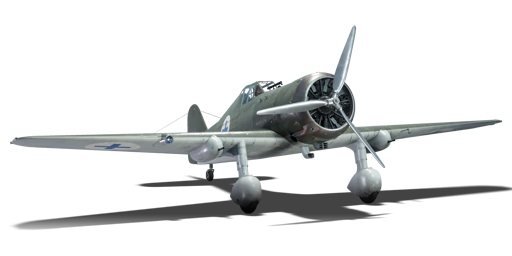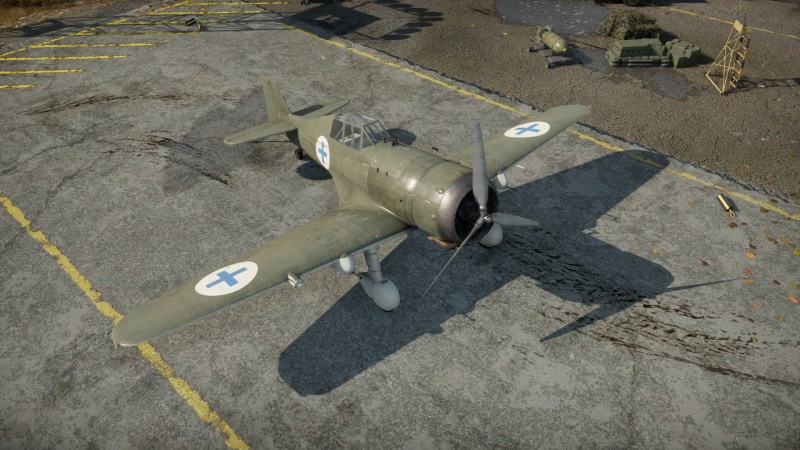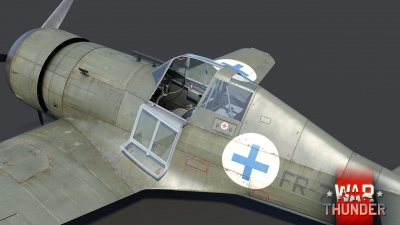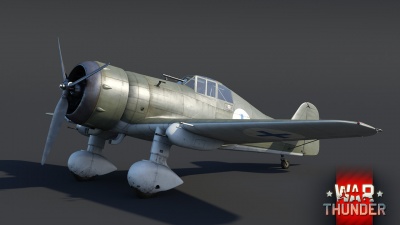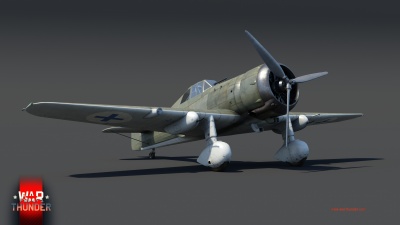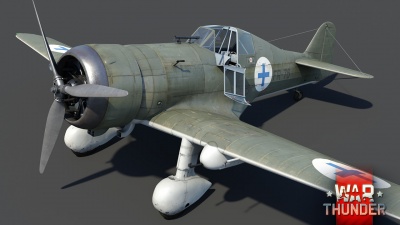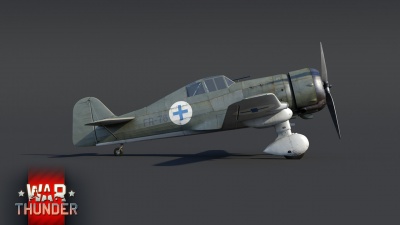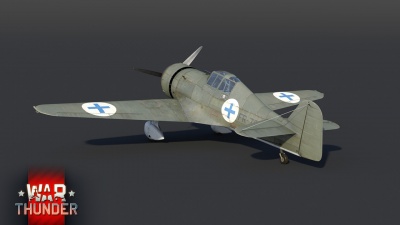Fokker D.XXI (Sweden)
| This page is about the premium fighter Fokker D.XXI (Sweden). For the regular version, see Fokker D.XXI-3 (Sweden). |
Contents
Description
The ▄Fokker D.XXI was designed by the Netherlands in 1935. It was meant to be a cheap and compact fighter, it served for both the Luchtvaartafdeling (Dutch Army Aviation Group) and the Finnish Air Force, some aircraft captured by Germany were actually placed in service with the Luftwaffe. The Fokker D.XXI was first used in combat by the Finnish Air Force during the 1939–1940 Winter War between the Soviet Union and Finland. The D.XXI was the successor to the D.XXI-3 in Finnish service, the only difference is the armament, with the D.XXI featuring 2 x Oerlikon 20 mm cannons, which was necessary after becoming increasingly obsolete during the Winter War. During the Continuation War, the Fokker was surprisingly effective, with some Finnish pilots even becoming ace fighters on it with the top scoring ace being Jorma Sarvanto. Finland continued to operate their D.XXIs until 1949, and classified them as surplus to requirements in 1952.
It was introduced in Update "Ixwa Strike". The ▄Fokker D.XXI is a slow but very agile fighter. It has a very similar performance to its predecessor, being slow but having a good climb rate. It has an increased firepower over the D.XXI-3, featuring 2 x 20 mm cannons that are very lethal at its BR. Try climbing to a good altitude since the start of the match, 4,000-5,000 m would be a good idea, so that you can dive and gain speed if you need to retreat. It is also particularly stable in simulator battles, so it's a beginner friendly aircraft. For its survivability, the aircraft has only a single fuel tank, so a leak would eventually result in the aircraft losing all the fuel, and a fire in that tank would also cause the aircraft to get destroyed. The new 20 mm cannons mean increased weight and the aircraft is slightly slower, the cannons are also prone to overheating and jamming, and have a low ammo pool.
General info
Flight performance
The Fokker D.XXI is a fairly pleasurable aircraft to play. Its manoeuvrability is quite good, being able to outturn a lot of aircraft of this BR. Also, its climb rate is great for its BR. However, keep in mind that it it rather slow, and might not be able to keep up with other fighters.
| Characteristics | Max Speed (km/h at 5,000 m) |
Max altitude (metres) |
Turn time (seconds) |
Rate of climb (metres/second) |
Take-off run (metres) | |||
|---|---|---|---|---|---|---|---|---|
| AB | RB | AB | RB | AB | RB | |||
| Stock | 409 | 399 | 10100 | 16.7 | 17.4 | 11.7 | 11.6 | 150 |
| Upgraded | 440 | 425 | 15.3 | 16.0 | 17.2 | 14.2 | ||
Details
| Features | ||||
|---|---|---|---|---|
| Combat flaps | Take-off flaps | Landing flaps | Air brakes | Arrestor gear |
| X | X | ✓ | X | X |
| Limits | ||||||
|---|---|---|---|---|---|---|
| Wings (km/h) | Gear (km/h) | Flaps (km/h) | Max Static G | |||
| Combat | Take-off | Landing | + | - | ||
| 735 | 290 | N/A | N/A | 240 | ~15 | ~6 |
| Optimal velocities (km/h) | |||
|---|---|---|---|
| Ailerons | Rudder | Elevators | Radiator |
| < 320 | < 240 | < 500 | > 320 |
Survivability and armour
- No armour
- Self-sealing fuel tanks (1 in front of pilot)
Modifications and economy
Armaments
Offensive armament
The Fokker D.XXI (Sweden) is armed with:
- 2 x 20 mm Oerlikon FF cannons, wing-mounted (60 rpg = 120 total)
- 2 x 7.7 mm FN-Browning M.36 No.3 machine guns, nose-mounted (500 rpg = 1,000 total)
Usage in battles
The Fokker D.XXI (Sweden) is highly agile for its class. This allows it to comfortably defend itself against most opponents, that will often struggle to get a good shot. The downside to its maoeuvrability is its speed. The Fokker D.XXI (Sweden) is quite primitive, with a lot of drag coming from both the landing gear and wing-mounted cannons. This makes the Fokker D.XXI (Sweden) unable to run away from most opponents, as even some biplanes are capable of catching up. This doesn't mean the plane is weak however, as the engine provides well over 700 horsepower to this light machine, allowing it to climb high above most targets.
The strategy when using the Fokker D.XXI (Sweden) should be to make the plane as light as possible, while using the engine to gain a height advantage. This can be achieved by taking the minimum amount of fuel, and putting the plane to a ~15° climb at take-off. This ensures that the plane will be the lightest aircraft at altitude, making any dogfight at height favorable, as most planes capable of reaching this height are much more cumbersome in comparison. Once the opponents up high have been cleared, the Fokker D.XXI (Sweden) is able to make use of the altitude to boom & zoom opponents below with ease, as the plane can safely dive without damaging itself.
| Pilots more comfortable with dogfighting can utilize the Landing flaps when stalling, to quickly flip back over. This allows for some advanced tactics against slower opponents. |
Manual Engine Control
| MEC elements | ||||||
|---|---|---|---|---|---|---|
| Mixer | Pitch | Radiator | Supercharger | Turbocharger | ||
| Oil | Water | Type | ||||
| Controllable | Controllable Not auto controlled |
Not controllable Not auto controlled |
Not controllable Not auto controlled |
Separate | Not controllable 1 gear |
Not controllable |
Pros and cons
Pros:
- Powerful armament consisting of 2 x 20 mms and 2 x 7.7 mms, can easily start fires and shred biplanes
- Above average climb rate for its BR
- Only one fuel tank, so fires usually would not be started if the aircraft was tailed
- Great turn time (16 seconds in RB)
- Engine takes a while to overheat on WEP
- Does not rip or even compress at little over 600 km/h, allowing it to safely dive on its opponents
- Short take-off run
- Very stable aircraft to fly in simulator battles
- As a premium aircraft, has better SL and RP rewards than regular aircraft
- Fixed landing gear makes landings easier and more simplified
Cons:
- Rather slow for its BR
- Only has landing flaps
- 20 mm cannons technically only have 60 rounds (60 rounds per gun, but they fire at the same time)
- Cannons have a rather slow rate of fire
- Cannons easily overheat after a short time of continuous firing
- No armour
History
Devblog
Development of what would become the Fokker D.XXI began in late 1934 with engineers at the Fokker company seeking to design a modern fighter aircraft, incorporating some of the latest aviation technologies. In 1935, the Dutch Air Force ordered the construction of a prototype which would be evaluated by its East Indies branch, as a result of the aircraft being seen as suitable for defending Dutch overseas assets.
Although its maiden flight in 1936 showed enough promise, the fate of the Fokker D.XXI was "hanging in the air" for a time due to a change in doctrine within the Dutch Air Force. As a result, Fokker began looking into promoting the aircraft on the export market, hoping to find foreign customers.
Fortunately, Fokker received interest from both Denmark and Finland to purchase a number of aircraft as well as rights to production. At the same time, domestic interest was also revived, resulting in the start of production in 1937.
Despite being a Dutch design, the Fokker D.XXI was predominantly produced and employed by Finland. Having built and operated around ⅔ of all D.XXIs, the Finnish Fokkers distinguished themselves during the Winter and Continuation War, although with less success in the latter due to their dated design. The Dutch Fokkers also put up a stiff resistance to the invading German forces in May 1940, shooting down a number of enemy aircraft, including several superior Messerschmitt Bf 109s. In the end, approximately 150 D.XXIs were built, serving up until 1949 with Finnish forces.
Media
- Skins
- Images
See also
Similar Swedish aircraft
Comparable aircraft
External links
- [Devblog] Fokker D.XXI: The Flying Dutchman
- Official data sheet - more details about the performance
| Royal Dutch Aircraft Factory Fokker (Koninklijke Nederlandse Vliegtuigenfabriek Fokker) | |
|---|---|
| Strike Aircraft | ◗Fokker G.IA |
| Jet Aircraft | ▄Meteor F Mk.8* · ◘Hunter F.6* |
| Export | ▄Fokker D.XXI-3 · ▄Fokker D.XXI |
| * Licensed Production / Variants | |
| See Also | Gloster · Hawker · Valtion Lentokonetehdas |
| Sweden fighters | |
|---|---|
| ASJA | J6B |
| Saab | J21A-1 · J21A-2 · A21A-3 |
| FFVS | J22-A · J22-B |
| Foreign Import | J8A · Iacobi's J8A · J9 Early · J11 · J20 · J26 David · J26 |
| Finland | |
| VL | Mörkö-Morane · VL Myrsky II · VL Pyörremyrsky |
| (NL) Fokker | ▄Fokker D.XXI-3 · ▄Fokker D.XXI |
| (DE) Messerschmitt | ▄Bf 109 G-2 · ▄Bf 109 G-6 Erla · ▄Bf 109 G-6 |
| Other | ▄B-239 · ▄Hurricane Mk I/L |
| Sweden premium aircraft | |
|---|---|
| Fighters | Iacobi's J8A · ▄Fokker D.XXI · Mörkö-Morane · VL Myrsky II · J9 Early · J26 David · VL Pyörremyrsky · ▄Bf 109 G-6 |
| Jet fighters | J29D · J35A · Saab J35XS |
| Strike aircraft | SAAB-105OE · A32A Röd Adam |
| Bomber | ▄Ar 196 A-5 |


